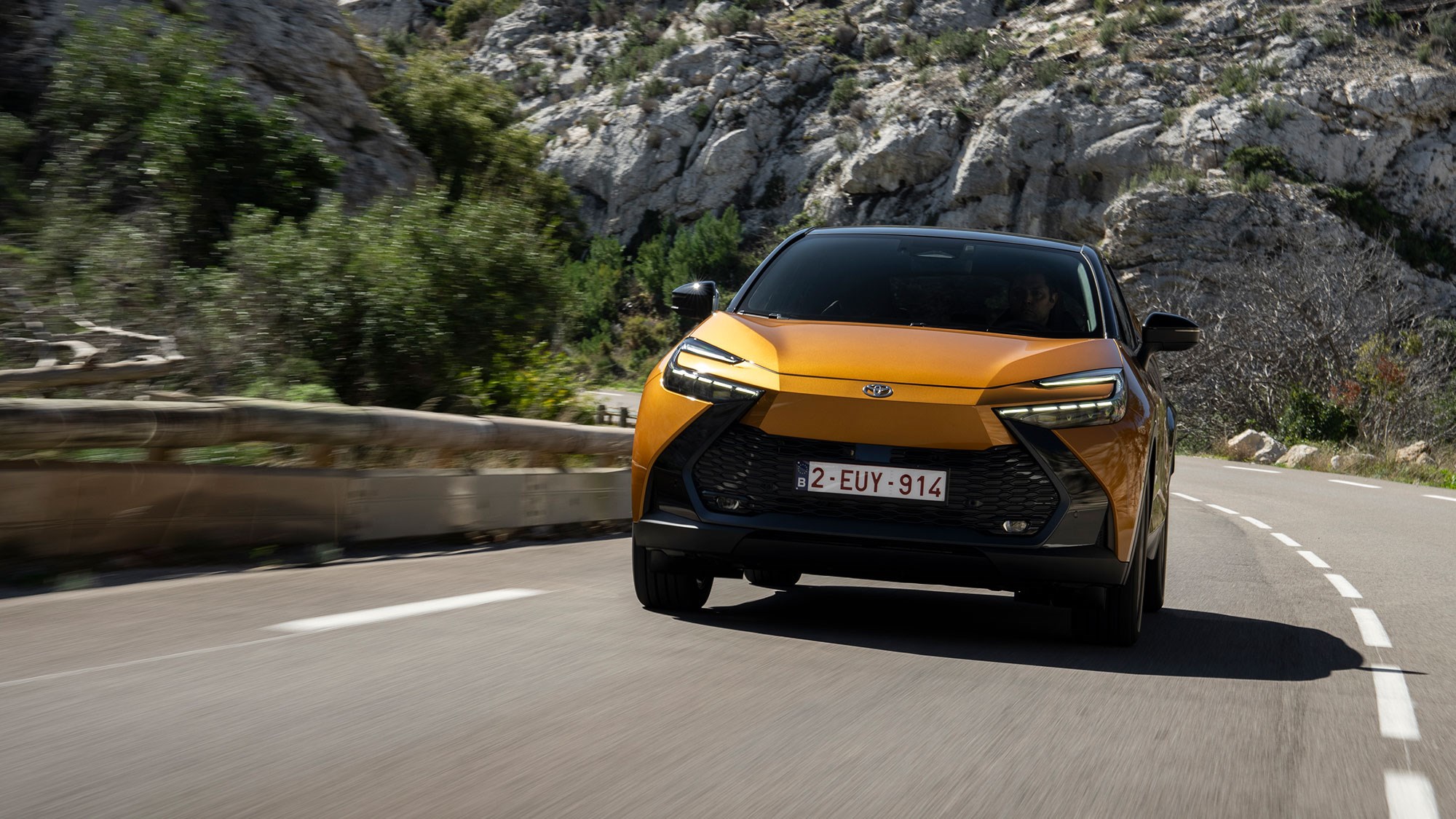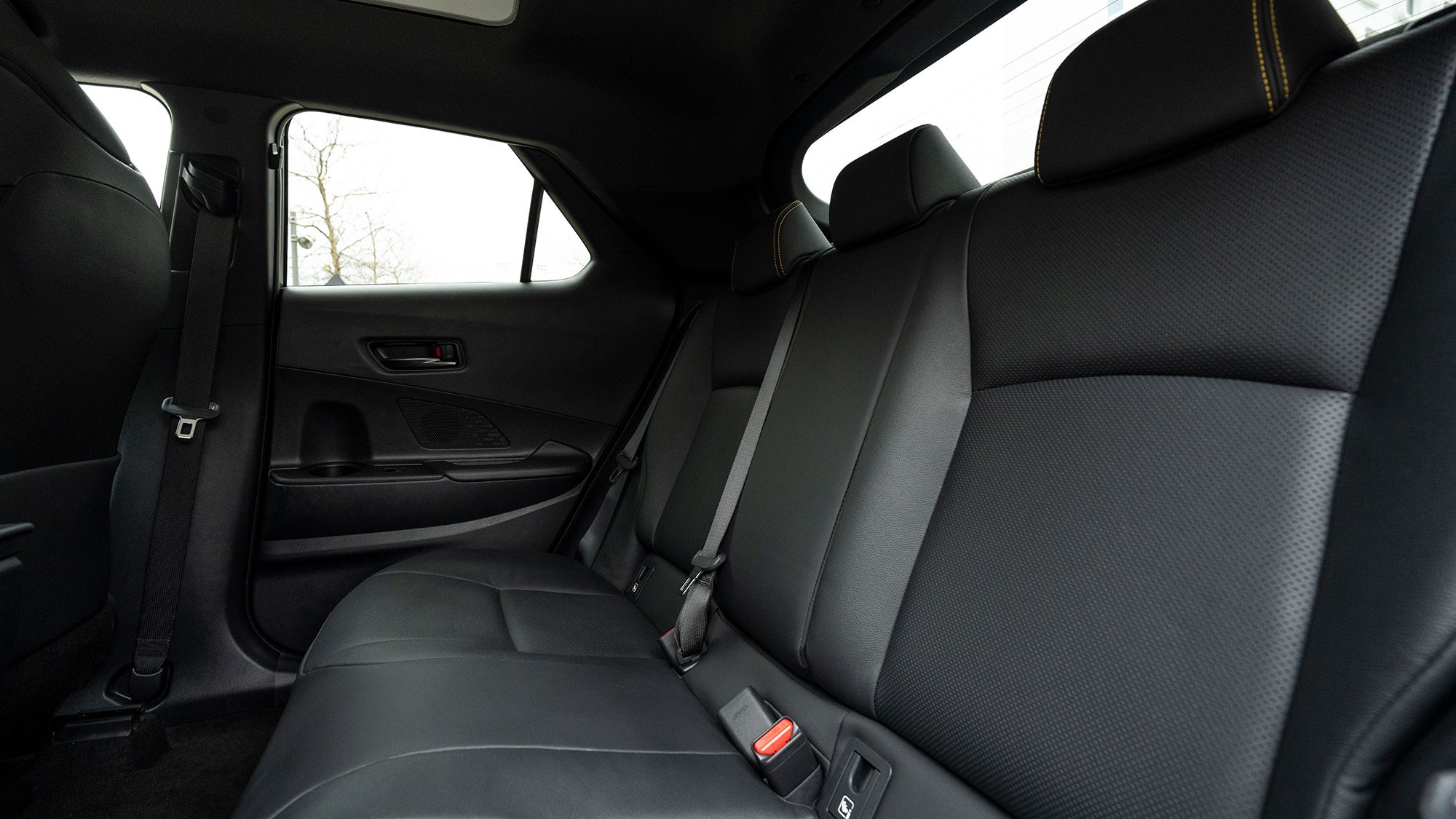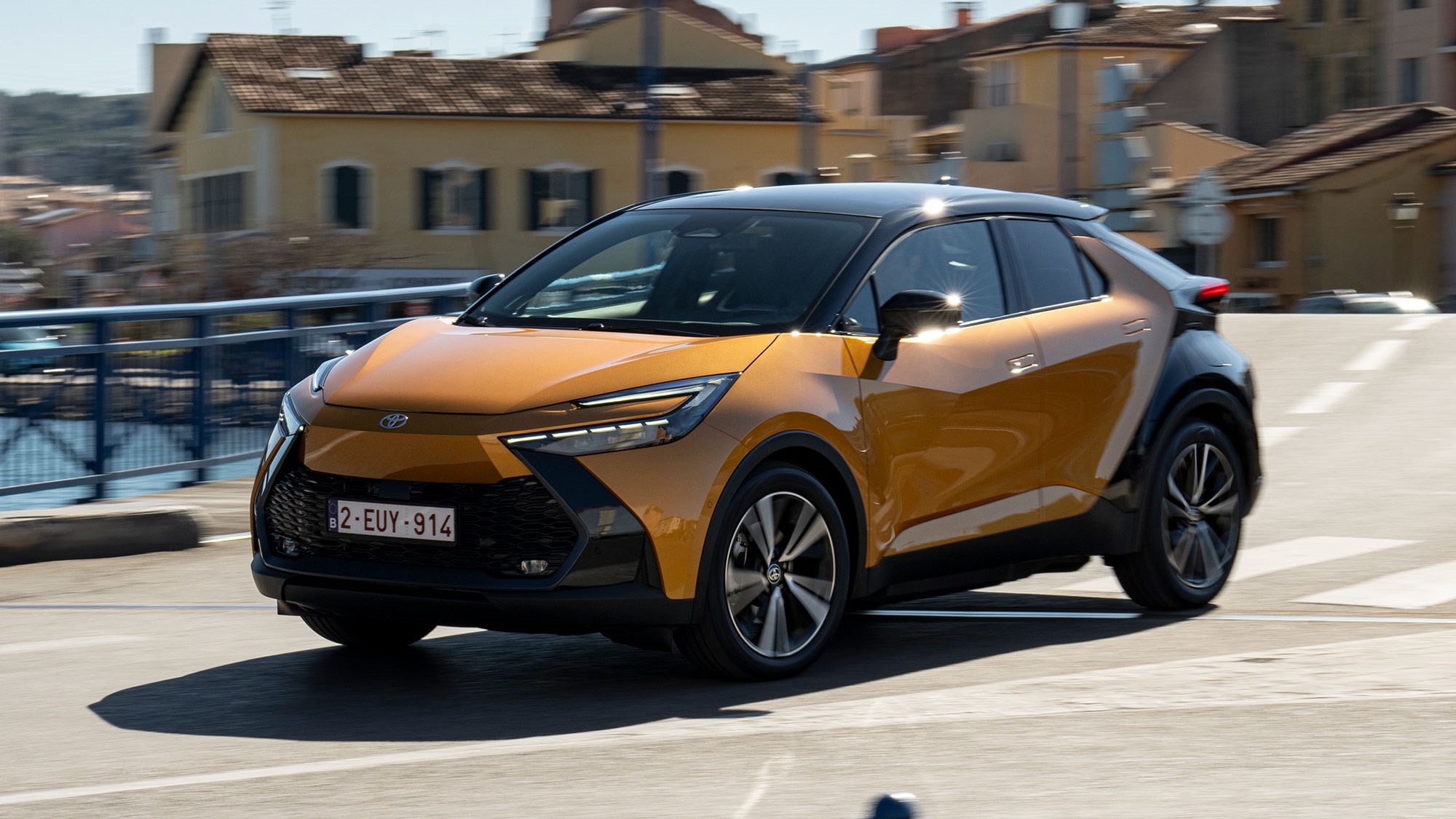► Toyota has made an even greener C-HR
► Maximum electric range of 41 miles
► More refined than standard hybrid
Toyota has launched a new, plug-in hybrid version of the Mk2 C-HR. And why wouldn’t it? The RAV4 proved the brand is good at building PHEVs – and it makes sense to offer the tech in an SUV that’ll probably spend most of its life pottering around town.
It probably just as well it arrived when it did, too, because Toyota is already playing catch up. The Kia Niro, which has long been a thorn in the C-HR’s side, has been available with both a hybrid and a plug-in hybrid powertrain since it hit UK showrooms.
But it’s better for Toyota to join the party late than never, we suppose. Plus, because it took its sweet time in piecing together a PHEV rival for the Niro, Toyota has been able to make a few improvements to its car. So, the C-HR PHEV has a bigger 13.6kWh battery (compared to 11.1kWh unit fitted to the Kia) and a longer maximum electric range of 41 miles.

Granted, that’s only another mile than you get from the most efficient version of the Niro, but every little helps, right? And, like the Niro, Toyota claims the C-HR can achieve more than 300mpg on the WLTP cycle, providing you maximise its electric range and charge up regularly.
When you team these slightly improved stats with the C-HR’s funkier styling and Toyota’s legendary reputation for reliability, we reckon the Kia might have a bit of a flight on its hands. Scroll down to find out the results of the sparring match.
What are the specs?
The Toyota C-HR PHEV uses the same 2.0-litre four-cylinder petrol engine as the most powerful self-charging hybrid model. However, it’s teamed with a more powerful electric motor and a much larger battery pack. The extra electrical assistance punts the car’s output from 194bhp to 220bhp. You get a lot more torque, too.
This extra grunt has had a significant impact on the way the C-HR accelerates. The PHEV can scream from 0–62mph in a blistering 7.4 seconds (yes, we’re being facetious – don’t leave a comment about it), compared to 8.1 seconds for the 2.0-litre hybrid model and 10.2 seconds for the 1.8-litre hybrid model. Crucially, it’s a good two seconds quicker over the sprint than the Niro.

Toyota also had to make a few changes to the C-HR PHEV to control the added weight and performance of its faster plug-in hybrid powertrain. So, there are new dampers on the rear axle to compensate for the weight of the battery pack and larger 17-inch brakes to rein in the thundering performance of the additional horses storming around the engine bay.
How does it drive?
It’s an awful lot like the standard C-HR, which is testament to the skill of Toyota’s engineers. When you’re bumbling around town or cruising down the motorway, the only appreciable difference between the two cars is how much quieter the PHEV’s cabin is.
You can feel the added weight of the battery pack when you pedal the car hard, though. The PHEV simply isn’t as agile as the self-charging C-HR, and we found it suffers from a little more body roll. But that’s to be expected because the battery adds 200kg to its kerb weight.
To try and minimise this effect, Toyota mounted the battery as low down and close to the centre of the car as possible. And it produced the right result. We couldn’t ever call it fun, but the C-HR PHEV is predictable, safe and planted in the corners.

Part of the reason our why opinion of the C-HR’s driving experience leans more towards ‘accomplished’ rather than ‘entertaining’ is its steering system. It has a little too much assistance and it’s incredibly numb. It’s very direct, in fairness, but it completely isolates you from the road which means you never have the confidence to push the limits of the chassis.
We can excuse that here, though, because the C-HR isn’t a car that was designed to appeal to keen drivers. Indeed, Toyota told us its primary foci for the C-HR were to make it look cool and sip fuel (both of which we think it’s achieved). The C-HR never encourages you to drive quickly, either. So, the numb steering is even less of a concern.
It also comes with an armoury of driver assistance technology, (such as lane-keeping assist and an automatic braking function that helps you maintain your distance from the car ahead), all of which are designed to shoulder as much of the driver’s cognitive load as possible.

Toyota’s tech also works well (better than any of its Volkswagen Group rivals, that’s for sure), which means you’re more likely to leave it on and enjoy an easier ride – especially when you’re on the motorway. Fitting the C-HR with the same racy steering rack as you get in, say, a GR Yaris would have ruined this experience.
What about the interior?
It’s exactly the same as the self-charging C-HR. Don’t mistake that for criticism, though, because the C-HR is a very nice place to be. We especially like the way the infotainment system and centre console wraps around the driver. It’s snug.
And because you can’t have the PHEV in Toyota’s most basic Icon specification, it’s only available with the firm’s larger 12.3-inch infotainment system. This is a good thing, because the larger screen makes it easier to hit the icons and read navigation instructions. As an added benefit, it looks swish and gives you tangible justification for the PHEV’s steeper base price.
The touchscreen is teamed with the same 12.3-inch digital gauge cluster you get on Design-spec versions of the C-HR self-charging hybrid but, because it’s wired into a PHEV system, it displays some extra info such as your remaining EV range and battery capacity.

Sadly, it has the same clumsy driver assistance menu as the standard car. That means, if you’re frustrated by a safety function, you need to delve into a submenu of gallingly obscure acronyms to disengage it. Worse still, some functions (such as the bonger for the road sign assist system) can’t be switched off unless the car is stationary – and everything is reset to ‘on’ when you turn the ignition off.
Quality is good overall, but you can tell where Toyota has trimmed its margins. The door cards feel rather cheap for a £40,000 car but, to be fair to Toyota, they should be easy to maintain. We’re not particularly fond of the dashboard trim near the A-panels, either. It almost feels like they were tacked on as an afterthought, as they wiggle on their mounts.
At least Toyota has packaged the cabin intelligently. The PHEV has the same amount of passenger space as the standard car because the battery pack and chargers are mounted under the floor of the cabin, about where they’d be on an EV. That means headroom and legroom are unchanged.

You can’t have it all, though. Toyota has had to sacrifice some boot space to make everything fit into the C-HR’s chassis – and the sacrifice is quite a big one. The standard 1.8-litre C-HR has 388 litres of boot space, while the PHEV only has 310.
What’s worse for Toyota is that Kia Niro PHEV has 348 litres of boot space. Then again, the Niro’s design has always focused more on function than form, so you need to decide what you value more – ruthless practicality or snazzy looks.
Fuel economy and maintenance
This where the C-HR claws back some ground. For starters, every model is eligible for Toyota’s industry-leading 10-year warranty (providing you get it serviced at an official Toyota dealership). Toyota also claimed the title of the most reliable car brand in the 2023 FN50 survey, stealing the title from BMW. So, you know it’s not going to break.
What’s more, Toyota is adamant that the C-HR can make up for its higher purchase price in fuel savings. It always starts in EV mode, and it’s 41 miles of electric range should be enough for the average UK commuter to get to and from work without burning a drop of petrol. Plus, the C-HR knows when it’s in an emissions-controlled area and will default to running in EV mode if it has enough charge in its battery pack.

We’re yet to test the electric range properly in the UK, but we spent an afternoon tooling around the centre of Marseille on the C-HR’s European launch and barely heard a peep from the petrol engine. That bodes well.
We very much doubt you’ll manage to achieve the C-HR’s official 300mpg-plus fuel economy figure in the real world, especially if you’re covering longer distances with an empty battery. Even with a flat battery, though, it should be economical. For context, the hybrid C-HR can easily return 50mpg, even when you’re not trying to drive efficiently. We’ll update you with more info once we’ve stress tested the PHEV on British roads.
What else should I know?
Well, you can’t have one yet. The plug-in hybrid C-HR won’t reach UK shores until July 2024. Also, because it’s being pitched as the flagship model of the SUV’s range, you can’t have it in Toyota’s cheapest Icon specification.
That’s good if you want the extra tech from the Design trim, but bad if you’re looking to save a few quid. Prices for the PHEV start from almost £40,000, which is a big jump over the £31,000 you’ll pay for the most basic self-charging C-HR. It’s also around £4,000 more than you’ll pay for the cheapest Kia Niro PHEV.

You do get slightly more standard equipment by opting for the Toyota, but we’re not sure whether it’s enough to sacrifice the extra practicality of the Kia. Extras include a blind-spot monitoring system, heated front seats and front fog lamps.
Also, if you step up to the mid-range Kia Niro PHEV 3, you’ll get more equipment than you get from the cheapest C-HR for less money. The Niro 3 HEV costs around £37,500, but adds extras such as a heated steering wheel, a wireless smartphone charger and lumbar support.
Verdict
Deciding whether the Toyota C-HR PHEV is the right car for you will depend on your circumstances. If you need a car to transport your family and all their clobber, you can probably do better. But if you want something that’s comfortable to sit in, interesting to look at and cheap to fuel, the Toyota C-HR PHEV could be ideal for you.
The C-HR’s plug-in hybrid powertrain is even quieter than the car’s self-charging hybrid systems – and because the electric motor can do more of the work, the CVT doesn’t feel the need to spike the engine revs to the moon when you’re accelerating. That 41-mile electric range is useful for folk living in emissions-controlled areas, too.
Just don’t expect its driving experience to be as interesting as its looks and, for the love of whatever deity you worship, spec it in a loud colour. Toyota does a range of wild two-tone paint finishes, including a pleasingly lairy orange and black ensemble. It’s worth the extra cash – the standard white paint finish is just depressing.
Setting the car’s styling aside, the C-HR PHEV is quite expensive when you compare it to the Niro – especially when you consider you can get a Niro that’s better equipped for less money. It isn’t the most practical car in its class, either and you lose a whopping 78 litres of boot space by opting for the extra electrical assistance.